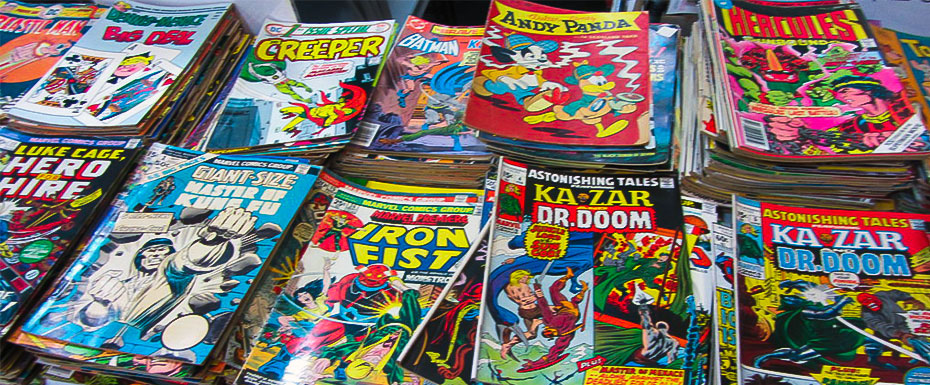
Comics are one of the most unique and outstanding cultural phenomena of the twentieth century. The creation of stories about superheroes and their subsequent drawing is a true art form. Yet, some people underestimate comics, considering them too ordinary and unsophisticated works of art. In fact, “stories in pictures” represent a massive layer in contemporary pop culture, and their creators are loved and admired around the world.
Since the appearance of Superman in Action Comics (1938), the number of artists drawing comics has grown steadily. Among them, you can find artists whose names have long been legends of the genre and those who have not yet succeeded in capturing the public’s attention. But each of them contributed or continues to contribute something unique and entirely new to the development of comic culture.
Jack Kirby
Jack Kirby, an outstanding American author, artist, and editor, is rightly considered the king of comics, one of the leading innovators who changed the comics industry forever.
 He brought American comics of the 1960s to a new level of visual and narrative excellence previously unavailable to other art forms. Thanks to his creative ideas, numerous stories, comics, and genres were born.
He brought American comics of the 1960s to a new level of visual and narrative excellence previously unavailable to other art forms. Thanks to his creative ideas, numerous stories, comics, and genres were born.
Later, working with Joe Simon, he gave the world the legendary superhero Captain America. In 1963, the first Avengers comic book was published. Created by Jack Kirby and Stan Lee, the super team that included Thor, Hulk, Iron Man, Ant-Man, and the Wasp became incredibly popular.
The first edition of the X-Men series (1963) was also a bestseller as it introduced the reader to new mutant characters. Captain America, Thor, the Hulk, the X-Men, the Fantastic Four – just a tiny fraction of the characters in Jack Kirby’s comics, whose adventures have been followed by millions of fans and admirers for decades. You can’t even imagine the MARVEL universe without this genius master.
The greatest artist of the twentieth century, Jack Kirby, will forever remain in the history of comics as a brilliant creator of famous superheroes and entire worlds and universes.
Will Eisner
Will Eisner, a prominent American-Jewish illustrator, is rightly considered the “father of the graphic novel” and one of the foremost representatives of the global comic book industry. He made a significant contribution to its development; more than one generation of talented authors and artists grew up on his works. The uniqueness of Will’s comics is that he drew not cosmic wars, superheroes, or extraterrestrial civilizations but real, like-minded people in different worldly situations.

He began his career drawing cartoons for metropolitan newspapers. Then, some of his short stories entitled “A contract with God” were published in 1938, and his most successful work was “the Spirit,” published in 1940. In 2008, an action film called “The Spirit” was made on its basis with the ubiquitous detective Danny Colt who was hiding his face under a mask.
The artist also spent a long time teaching students the art of cartoon drawing at the School of Visual Arts in New York City, where many of today’s illustrators and designers studied under him.
Later, books such as ” Life Force” and “Dropsy Avenue” were published, becoming the logical conclusion of the “Contract with God” trilogy. In 1978, the term “graphic novel” was first used as a successful publicity stunt for the book “A contract with God.” The acclaimed comic book author combined four touching stories of the residents of a rented house about faith, love, and betrayal into one stunning graphic novel, thus setting a new direction for contemporary graphic storytelling.
“To the Heart of the Storm” is one of Eisner’s best works, introducing the reader to the difficult life of an immigrant Jewish family in America in the 1930s and 1940s. In this comic book, he depicts a conscript riding on a train, the windows of which flicker with memories of childhood and adolescence. The word “storm” in the title refers to war, and the conscript stands for Eisner himself. The new adventures of his characters are a credit to artist and writer Gary Chaloner.
Stephen J. Ditko

One of the most famous comic book illustrators, Steve Ditko, is the co-author of such iconic characters as Spider-Man, Doctor Strange, and the developer of Iron Man and Incredible Hulk. For a long time, Steve worked closely with Stan Lee at Marvel Comics Studios. In the end, his groundbreaking work on the image of Spider-Man brought both the superhero and the incredible artist success and worldwide recognition. Ditko’s illustrations vividly show the full range of the characters’ emotions, be it mild anxiety, blind rage, simple wonder, intrigue, and so forth.
Since childhood, Ditko has been obsessed with comic books, his favorite character being Batman, who first appeared in the early 1940s. Attending animation and illustration school, he never missed a lecture by his idol Jerry Robinson, who drew the first Batman comics. Then, in 1953, Ditko began working as a sketch artist at Joe Simon and Jack Kirby’s studio, learning from the authors of the famous Captain America.
In 1955, he began working at Atlas Comics, later renamed Marvel Comics, where fate brought him together with Stan Lee. This collaboration gave the world one of the best superheroes of our time, the main character of Marvel – Spider-Man (1961), and a completely new way of creating comics, called the “Marvel method.” Together with Stan Lee, the artist also worked on the surreal Doctor Strange. In 1966, Ditko left Marvel and two years later (1988) moved to DC publishing, then also decided to leave after one year.
The artist subsequently drew for various publications, including Marvel and DC’s rivals. Since mid-2012, Ditko has continued to work at the studio in Manhattan, but unfortunately, since the 1960s, Ditko has not given interviews, refused to be filmed for shows, and made no public statements. Despite this, in the memory of fans and admirers of his talent, he will forever remain a cult figure, just like his famous superheroes.
John Romita Jr.

Comic book author and illustrator John Romita, Jr. is one of Spider-Man’s regular artists and the creator of one of the best superheroes of our time, Tony Stark. He made his debut in 1977 when he illustrated the Spider-Man series, which was very important to the young illustrator because his father (John Romita St.) worked on this iconic Spider-Man series, replacing the legendary Steve Ditko.
After working as an assistant artist, Romita Jr. begins working on his projects. His popularity started to grow after the appearance of the Iron Man comic book series, the story of one of the most widely publicized superheroes. The period 1983-1986 was marked by his work on the Uncanny X-Men series.
At the age of thirty, he had already made his name and developed his unique style using some details of his father’s work and adapting them to the demands of the modern comics industry. In 1988, John began working on a comic book about Daredevil in close collaboration with writer Ann Nocenti and cartoonist Al Williamson. While working on the adventures of Daredevil, the artist concluded that he needed to change his drawing technique, so sharper and more complex drawings replaced the traditional drawing. Later, John worked with almost all popular Marvel comics and their famous heroes.





